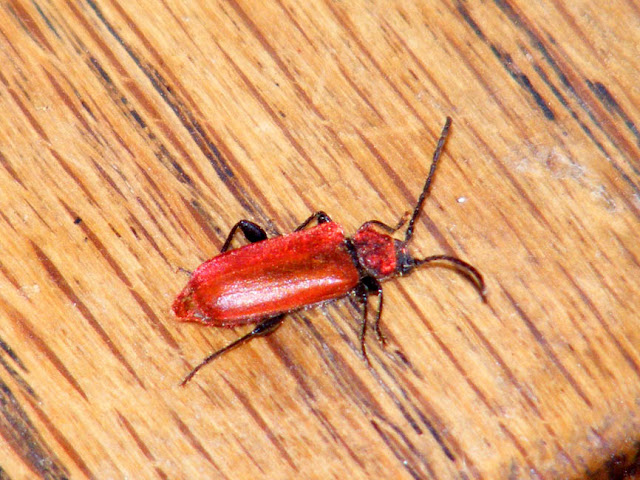I was recently in a Facebook discussion with someone living near Stockholm about some beetles that she had appear in the house. They were longhorns so we are fairly sure they have emerged out of her firewood which has been brought into the house. This happens to us here in the Loire Valley too, so I thought I'd write a blog post about the species we've met as a result of having a wood stove.
Lesser Capricorn Cerambyx scopoli (Fr. Petite capricorne)
A very rugged black beetle with a textured look. Ponderous and immensely strong they are not too fussy about their host tree. The larvae will bury themselves in the living heartwood of mature broadleaf deciduous trees that are a bit isolated and get a lot of sun. If you frighten them the adults will squeak at you in protest.
Welsh Oak Longhorn Beetle Pyrrhidium sanguineum (Fr. Callidie sanguine)
This is the most common firewood emergeant, the smallest, but the most visible. The red colouration is not created by the pigmentation in the wing
cases, but is more like a red gold dusting of scales and hairs that can
be rubbed off to reveal a glossy black beetle beneath.
Plagionotus arcuatus (Fr. Clyte arqué)
Such a good wasp mimic it's easy to be fooled, but it is actually a type of longhorn beetle, readily identifiable by the bow shaped yellow markings. The beetles can be anything from 8 to 20 mm in length. It is lustrous black with bright yellow spots and stripes. The legs and antennae are orangey brown. They like to hang out in the sunshine on dead oak and beech. Their colouring makes them look like wasps, but to add to the effect in life they move like Vespula spp wasps. A charming and pretty beetle.
Spotted Longicorn Chlorophorus glabromaculatus (Fr. Clyte poilu)
A black beetle that is covered in golden down, except for a series of spots on the wing cases and thorax. Adults eat pollen and can be found in gardens. The larvae like dry dead wood, especially oak, but sometimes other deciduous trees.
Sometimes the beetle doesn't get a chance to emerge. The last photo shows a larva of a longhorn beetle Cerambycidae in our oak firewood.
I'm told it is likely to be Leptura sp or Clytus sp, or a closely
related genus. Based on that and the size of the larva, I think it could
be either Plagionotus arcuatus (Fr. Clyte arqué) or Spotted Longicorn Chlorophorus glabromaculatus (Fr. Clyte poilu).
************************************************
For details of our private guided tours of chateaux, gardens, wineries, markets and more please visit the Loire Valley Time Travel website. We would be delighted to design a tour for you.
We are also on Instagram, so check us out to see a regularly updated selection of our very best photos.
We are also on Instagram, so check us out to see a regularly updated selection of our very best photos.






4 comments:
Great memory. It took us a while to realise they came out of the wood. It could well of been you that told us!!! We now get very small black flies from the house plant compost.
Nice post....
Sciaridae Dark-winged Fungus Gnats are the most likely small black flies emerging from potting mix.
Thank you.
Post a Comment